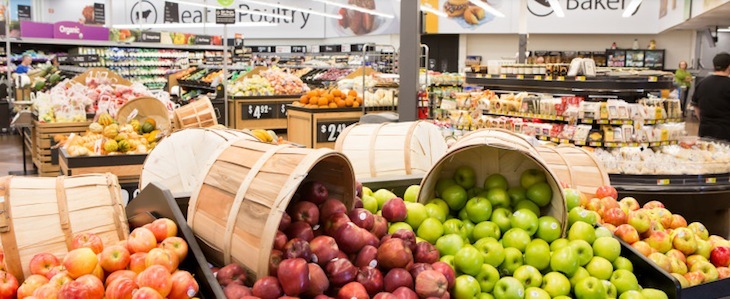J.P. Morgan analyst says Wal-Mart seen as a winner in grocery war
by October 24, 2017 5:27 pm 1,033 views

Retailers can’t afford to lose on price in today’s value-oriented world, according to J.P. Morgan retail analyst Christopher Horvers.
“I think Wal-Mart understands that,” he told members of the Northwest Arkansas retail supplier community Tuesday (Oct. 24) at the Doing Business in Bentonville breakfast.
He said some retailers are trying to run in the middle of the pack and not make the necessary investments in bridging online with brick and mortar. They think by staying in the middle there will be others ahead of them which are eaten first. Horvers said there will continue to be a shift in share among grocery and food retailers in the next few years.
“Wal-Mart knows this. Kroger also understands as does Costco, but they’ve been slower to invest in e-commerce. … I see the big getting bigger and those retail grocery brands that don’t invest heavily in price and online capabilities are likely to go out of business. It’s a function of time,” he said.
He said Wal-Mart execs are understandably excited about positive store traffic progress given that it’s also mirrored by positive comp sales growth. He said online grocery pickup is at the core for what is driving the traffic and comp-sales brick and mortar metrics for the retailer’s U.S. business.
Horvers projects the e-commerce contribution to Walmart’s U.S. traffic and comp-sale metrics will be 1.5% next year. In the first half of this year e-commerce contributed 0.8% in the first quarter and 0.7% in the second quarter. Wal-Mart said it will have 1,100 stores in the U.S. equipped for grocery pickup by year-end and plans to add another 1,000 in calendar 2018.
Volatile food prices tend to help value retailers like Wal-Mart as Horvers said the retailer can build better margins when prices are moving. When prices are falling, Wal-Mart’s gross margins improved throughout the back half of 2015 and most of 2016. When prices started back up early this year, Wal-Mart made price investments keeping prices lower longer than competitors, and is then able to take some market share, he explained.
Horvers said the investment community is excited to see Wal-Mart’s solid financials which have materialized over the past three years. That said, Horvers expects sales growth for Walmart U.S. to be lower next year at 1.8%, compared to 2.7% forecast this year and 3.2% attained in 2016. The usual growth engine for Wal-Mart has been turned upside down since 2015 when it stopped investing in more stores and amped up the investments in e-commerce. He said the retail giant has still managed to keep a steady gross margin and expenses are expected to be lower through 2019.

He points to a couple of areas where the retail giant is paring down expenses. Inventory is one, saying over the past two years Wal-Mart has reduced its inventory by $9 billion to $10 billion and most of that has been dragged out of the U.S. business. In 2015, Wal-Mart has an average 45 days of inventory on-hand, now down to about 43 days and likely to go lower.
Horvers said capital expenditures are the other area where Wal-Mart is reducing investment. In 2013 the retailer spent $13.1 billion, and this year capex is forecast at $10.4 billion, a level he believes Wal-Mart will hold steady through 2019. Holding down spending and inventory costs are one way the retailer can fund a more aggressive share buyback which fell to a low of $1 billion in 2014, but rose to $8.3 billion last year. It’s projected to reach $9.3 billion this year and grow to $9.5 billion and $10.4 billion in the next consecutive years.
Horvers said Wall Street likes that earning growth is back on the table after a three-year hiatus. He forecast earnings to grow 1.3% this year, bumping to 5.9% and 6.2% gains in the next two back-to-back years. E-commerce will begin to add incremental gains to Wal-Mart’s earnings as more sales gravitate online.
Consumer packaged goods already command 8.3% share of online dollars spent. Horvers said food penetration is still below 2% and that’s the wild, wild west of retail with every gunslinger trying to stake a claim. He told suppliers that online grocery sales were only going to accelerate. He said Wal-Mart is contemplating same-day delivery in some metro areas, whereas pickup will be the option many consumers continue to choose. Importantly, he said, Wal-Mart is making the right moves to stay relevant.
He said Amazon is a threat to everyone and they too, are going after the untapped fresh grocery share. He said the Whole Foods play will help them figure out a business they haven’t been able to crack thus far. He said Amazon needs brands and Whole Foods is a trusted grocery brand with a core following. When asked if Wal-Mart might look at possibly acquiring Sprouts or some other fresh food player, Horvers said he expects Wal-Mart to figure it out on their own. He does see opportunities for Wal-Mart to invest in another technology play for final mile, or some e-commerce or supply chain help, but said they don’t need to buy a grocer.
Horvers said regional grocery players like HEB in Texas and Publix in Florida each have proven models around customer service and delivering what their customers want. He said private companies might have an edge over those traded publicly because there will be more blood spilt in the grocery war as Lidl and Aldi expand their U.S. footprints and Wal-Mart continues to poke Amazon.
“Whether you are big or small, brands have to be online. It might just be 2% of sales now but it will be 10% in a few years,” he said. “Those retailers that can figure it out and still make money will be the ones who survive.”
